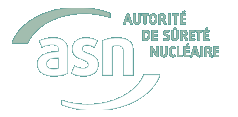| Chapter 16 |
- RADIOACTIVE WASTE
- Radioactive waste management regulatory framework
- Production of radioactive waste in basic nuclear installations
- Production of radioactive waste by other facilities using radioactive materials
- The national inventory of radioactive materials and waste
- The national radioactive materials and waste management plan
- The ASN role in the radioactive waste management system
- Checks and inspections
- Drafting of recommendations and prescriptions for sustainable waste management
- Production of the legislative and regulatory framework
- Evaluation of the nuclear financial costs
- ASN’s contribution to international works
- Public information
- Management of waste from nuclear licensees
- CEA waste management
- AREVA waste management
- EDF waste management
- Management of waste from small-scale nuclear activities
- Long-term waste management
- The very low level waste repository (CSTFA)
- The surface repositories for low and intermediate level, short-lived waste
- Management of long-lived high and intermediate level waste
- Management of long-lived low level waste
- Package acceptance in disposal facilities
- MANAGEMENT OF SITES AND SOILS CONTAMINATED BY RADIOACTIVITY
- Regulatory framework
- Revision of the contaminated sites management methodology guide
- The Radium Diagnosis operation
- The main subjects examined by ASN
- Coudraies district in Gif-sur-Yvette (Essonne)
- Clos rose district in Gif-sur-Yvette (Essonne)
- Making safe the Isotopchim site in Ganagobie (Alpes-de Haute-Provence département)
- Rehabilitation of the site of the former Pierre et Marie Curie school at Nogent-sur-Marne
(Val-de-Marne département)
- Établissements Charvet in l’Ile Saint-Denis (Seine-Saint-Denis département)
- Former Curie laboratories in Arcueil (Val-de-Marne département)
- Orflam-Plast in Pargny-sur-Saulx (Marne département)
- The Boucau site (Pyrénées-Atlantiques département)
- Support for the State’s regional services
- International action concerning management of contaminated sites and soil
- OUTLOOK
|
|
Generally speaking, ASN considers that the French radioactive
waste management system, built around a specific body of
legislative and regulatory texts, a national radioactive materials
and waste management plan and an agency dedicated to the
management of radioactive waste, is capable of regulating and
implementing a structured and coherent national waste management
policy.
In 2011, ASN continued with its actions aimed at ensuring
that radioactive waste is managed safely, from the moment it is
first produced. ASN thus regulates its management within the
nuclear installations and periodically assesses the strategies put
in place for this purpose by the licensees. ASN in particular
remains attentive to ensuring that the licensees recover the
legacy waste stored on their sites. ASN notes that the licensees
are late in doing this or are experiencing technical difficulties,
leading to postponement of the dates for removal from storage
of legacy waste on the La Hague and CEA sites. In addition, in
2012, ASN will continue to follow attentively the retrieval from
storage of wastes presenting the greatest safety challenges.
With regard to the long-term management of radioactive
waste, ASN is encouraged by the way ANDRA operates its disposal
facilities. ASN considers that there must eventually be
safe disposal routes for all waste. To this end, it is of the opinion
that France should be provided with a facility to allow
disposal of low level long-lived waste. ASN will therefore
attentively follow the process of searching for a site and the
development of disposal facility design.
With regard to high and intermediate level, long-lived waste,
ASN considers that key steps in the development of the disposal
project will be reached in the next few years. In its opinion
issued on the file submitted by ANDRA in 2009, ASN determined
the main areas for work that needed to be taken further
before the creation authorisation application, which should be
submitted at the end of 2014. ASN in particular recommended
that ANDRA further analyse certain risks linked to operation of
the facility, clarify the technical measures to be taken to
manage these risks and use demonstrators to complete its
understanding of the damage resulting from the excavation of
major structures and to qualify the techniques for sealing the
drifts and the connections between the surface and the underground
facility. ASN remains vigilant in ensuring that ANDRA
provides the expected elements.
Together with the stakeholders, 2012 will be more particularly
devoted to drafting the new edition of the PNGMDR for the
period 2013-2015. This work will be an opportunity to present
the progress made in the management of radioactive
waste, as linked to the provisions of the previous plan and to
define new objectives for continuous improvement of radio -
active materials and waste management. ASN will thus ensure
that the OPECST recommendations are taken into account and
that this work is in line with the requirements of the European
directive on radioactive waste recently adopted14. ASN will
also continue its involvement in work being done on these
topics internationally, in particular within ENSREG and the
WENRA club of nuclear regulator associations.
ASN has focused more closely on contaminated sites and soils
since 2009 and this will continue in 2012, together with the
administrations concerned and the other stakeholders. After
consultation, ASN issued several opinions in 2011 on polluted
site rehabilitation projects and was particularly closely involved
in operational oversight of the Radium Diagnosis operation.
At the end of 2011, ASN, the Ministry for the
Environment and IRSN, published the revised methodology
guide for management of sites and soils contaminated by
radioactive substances. This publication will be the opportunity
in 2012 for ASN to fix its doctrine concerning polluted
site and soil rehabilitation principles. ASN restates its position
that the solution involving maintaining the contamination insitu
must not be the reference solution for management of sites
polluted by radioactive materials and that this option can only
be an interim solution or reserved for situations in which the
complete clean-out option cannot be contemplated, in parti -
cular owing to the volume of waste to be excavated. Finally, in
2012, ASN will continue to oversee the diagnosis operations
on sites liable to have housed activities utilising radium in the
Ile-de-France region.
|




